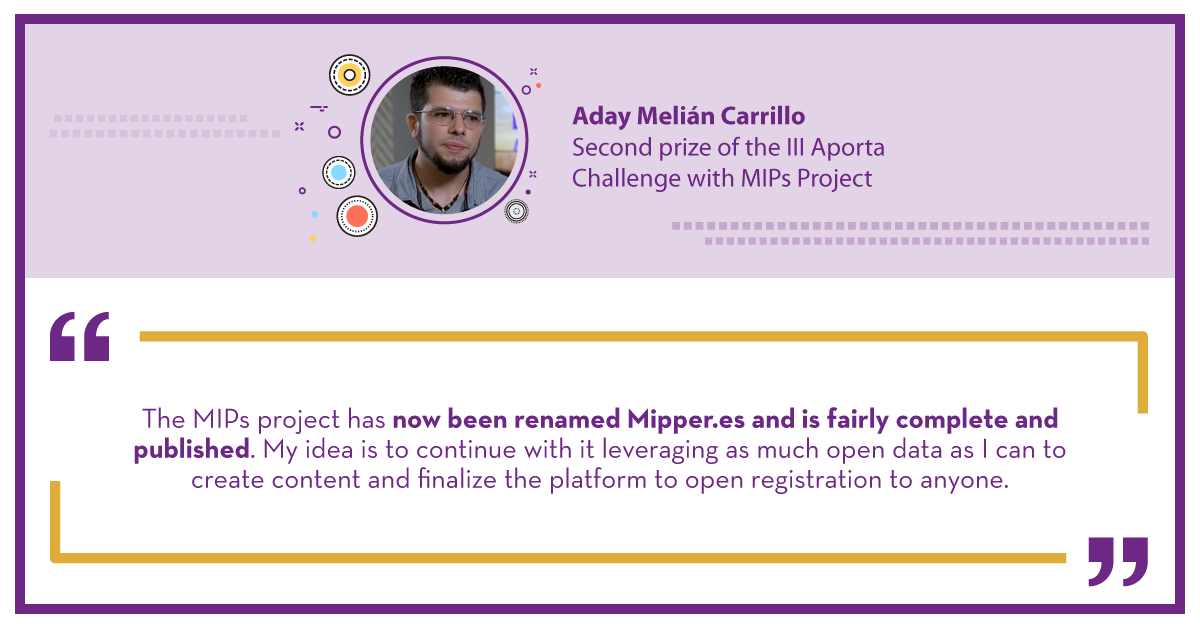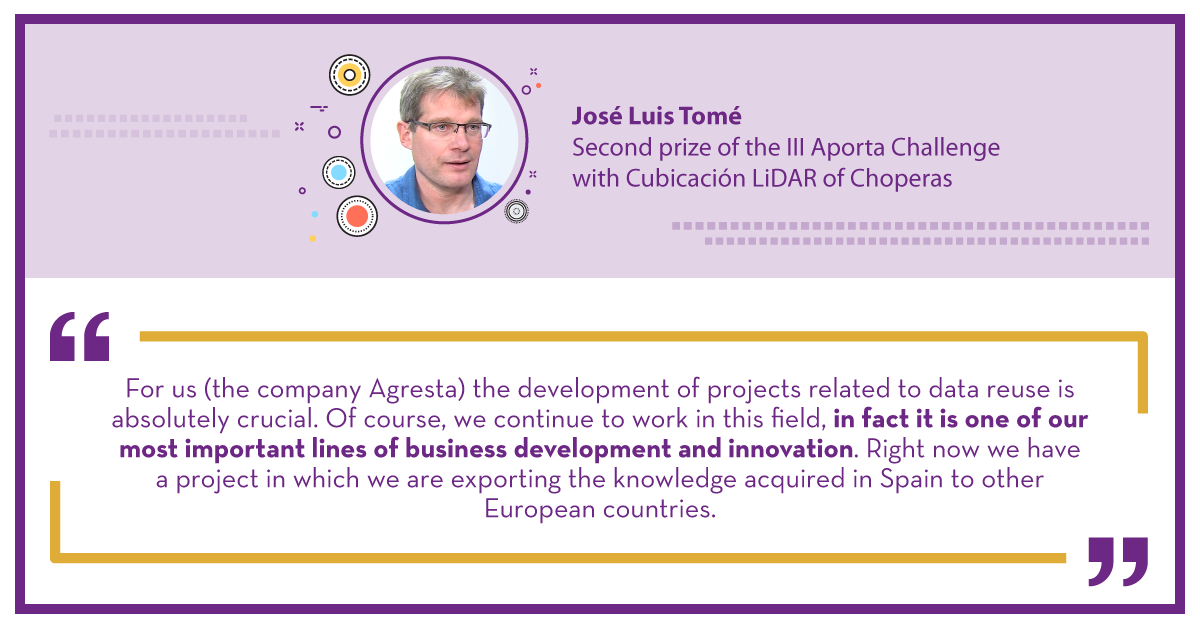The IV edition of the Aporta Challenge, whose motto has revolved around 'The value of data for health and well-being of citizens', has already announced its three winners. The competition, promoted by Red.es in collaboration with the Secretary of State for Digitalisation and Artificial Intelligence, launched in November 2021 with an ideas competition and continued earlier this summer with a selection of ten finalist proposals.
As in the three previous editions, the selected candidates had a three month period to transform their ideas into a prototype, which they presented in person at the final gala.
In a post-pandemic context, where health plays an increasingly important role, the theme of the competition sought to identify, recognise and reward ideas aimed at improving the efficiency of this sector with solutions based on the use of open data.
On 18 October, the ten finalists came to the Red.es headquarters to present their proposals to a jury made up of representatives from public administrations, organisations linked to the digital economy, universities and data communities. In just twelve minutes, they had to summarise the purpose of the proposed project or service, explain how the development process had been carried out, what data they had used, and dwell on aspects such as the economic viability or traceability of the project or service.
Ten innovative projects to improve the health sector
The ten proposals presented to the jury showed a high level of innovation, creativity, rigour and public vocation. They were also able to demonstrate that it is possible to improve the quality of life of citizens by creating initiatives that monitor air quality, build solutions to climate change or provide a quicker response to a sudden health problem, among other examples.
For all these reasons, it is not surprising that the jury had a difficult time choosing the three winners of this fourth edition. In the end, HelpVoice initiative won the first prize of €5,000, the Hospital Morbidity Survey won the €4,000 linked to second place and RIAN, the Intelligent Activity and Nutrition Recommender, closed the ranking with third place and €3,000 as an award.
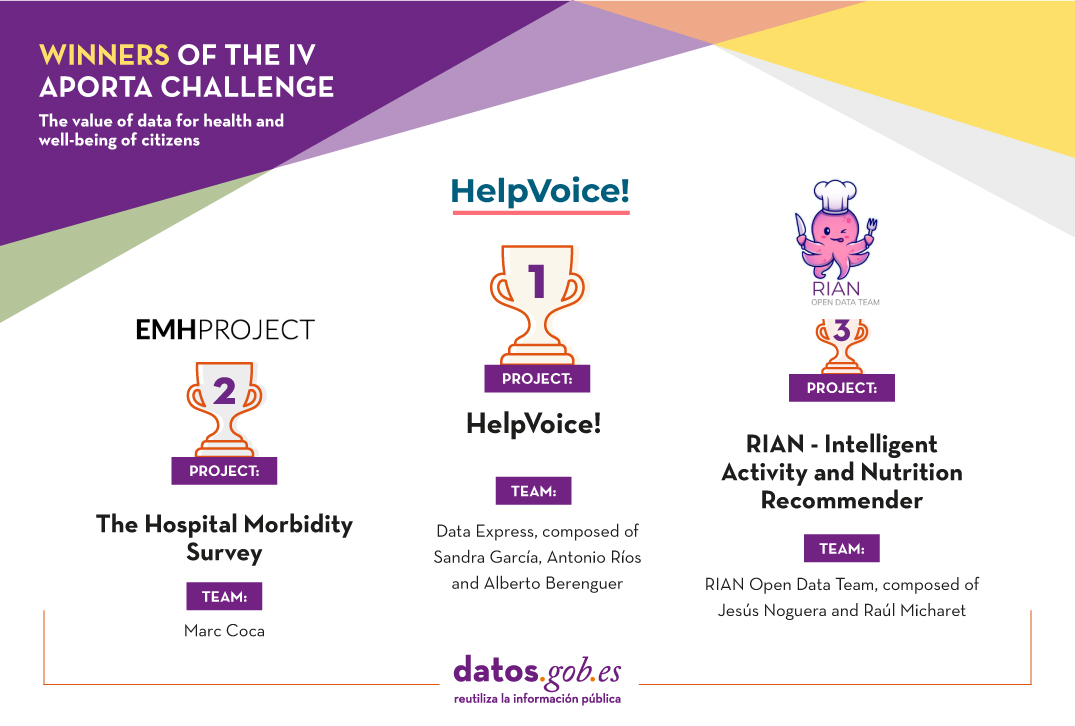
First prize: HelpVoice!
- Team: Data Express, composed of Sandra García, Antonio Ríos and Alberto Berenguer.
HelpVoice! is a service that helps our elderly through voice recognition techniques based on automatic learning. Thus, in an emergency situation, the user only need to click on a device that can be an emergency button, a mobile phone or home automation tools and tell about their symptoms. The system will send a report with the transcript and predictions to the nearest hospital, speeding up the response of the healthcare workers.
In parallel, HelpVoice! will also recommend to the patient what to do while waiting for the emergency services. Regarding the use of data, the Data Express team has used open information such as the map of hospitals in Spain and uses speech and sentiment recognition data in text.
Second prize: The Hospital Morbidity Survey
- Team: Marc Coca Moreno
This is a web environment based on MERN, Python and Pentaho tools for the analysis and interactive visualisation of the Hospital Morbidity Survey microdata. The entire project has been developed with open source and free tools and both the code and the final product will be openly accessible.
To be precise, it offers 3 main analyses with the aim of improving health planning:
- Descriptive: hospital discharge counts and time series.
- KPIs: standardised rates and indicators for comparison and benchmarking of provinces and communities.
- Flows: count and analysis of discharges from a hospital region and patient origin.
All data can be filtered according to the variables of the dataset (age, sex, diagnoses, circumstance of admission and discharge, etc.).
In this case, in addition to the microdata from the INE Hospital Morbidity Survey, statistics from the Continuous Register (also from the INE), data from the ICD10 diagnosis catalogues of the Ministry of Health and from the catalogues and indicators of the Agency for Healthcare Research and Quality (AHRQ) and of the Autonomous Communities, such as Catalonia: catalogues and stratification tools, have also been integrated.
You can see the result of this work here.
Third prize: RIAN - Intelligent Activity and Nutrition Recommender
- Team: RIAN Open Data Team, composed of Jesús Noguera y Raúl Micharet..
This project was created to promote healthy habits and combat overweight, obesity, sedentary lifestyles and poor nutrition among children and adolescents. It is an application designed for mobile devices that uses gamification techniques, as well as augmented reality and artificial intelligence algorithms to make recommendations.
Users have to solve personalised challenges, individually or collectively, linked to nutritional aspects and physical activities, such as gymkhanas or games in public green spaces.
In relation to the use of open data, the pilot uses data related to green areas, points of interest, greenways, activities and events belonging to the cities of Malaga, Madrid, Zaragoza and Barcelona. In addition, these data are combined with nutritional recommendations (food data and nutritional values and branded food products) and data for food recognition by images from Tensorflow or Kaggle, among others.
Alberto Martínez Lacambra, Director General of Red.es presents the awards and announces a new edition
The three winners were announced by Alberto Martínez Lacambra, Director General of Red.es, at a ceremony held at Red.es headquarters on 27 October. The event was attended by several members of the jury, who were able to talk to the three winning teams.

Martínez Lacambra also announced that Red.es is already working to shape the V Aporta Challenge, which will focus on the value of data for the improvement of the common good, justice, equality and equity.
Once again this year, the Aporta Initiative would like to congratulate the three winners, as well as to thank the work and talent of all the participants who decided to invest their time and knowledge in thinking and developing proposals for the fourth edition of the Aporta Challenge.
Last November, Red.es, in collaboration with the Secretary of State for Digitalisation and Artificial Intelligence launched the 4th edition of the Aporta Challenge. Under the slogan "The value of data for health and well-being of citizens", the competition seeks to identify new services and solutions, based on open data, that drive improvements in this field.
The challenge is divided into two phases: an ideas competition, followed by a second phase where finalists have to develop and present a prototype. We are now at the halfway point of the competition. Phase I has come to an end and it is time to find out who are the 10 finalists who will move on to phase II.
After analysing the diverse and high-quality proposals submitted, the jury has determined a series of finalists, as reflected the resolution published on the Red.es website.
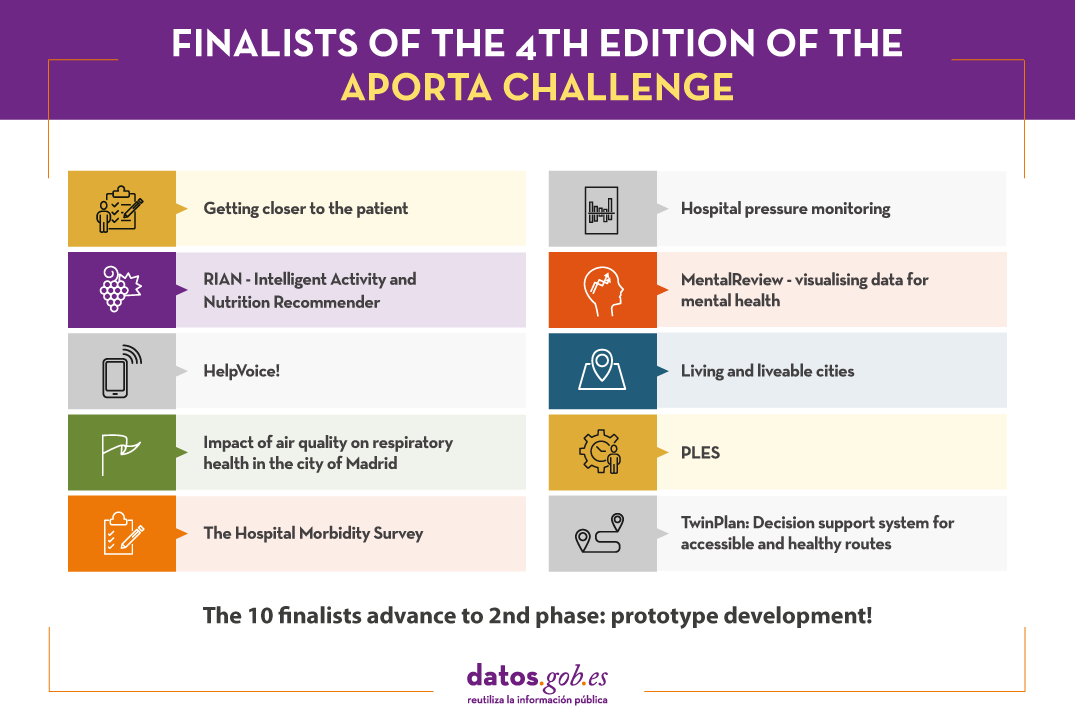
Let us look at each candidacy in detail:
Getting closer to the patient
- Team:
SialSIG aporta, composed of Laura García and María del Mar Gimeno.
- What does it consist of?
A platform will be built to reduce rescue time and optimise medical care in the event of an emergency. Parameters will be analysed to categorise areas by defining the risk of mortality and identifying the best places for aerial rescue vehicles to land. This information will also make available which areas are the most isolated and vulnerable to medical emergencies, information of great value for defining strategies for action that will lead to an improvement in the management and resources to be used.
- Data
The platform seeks to integrate information from all the autonomous communities, including population data (census, age, sex, etc.), hospital and heliport data, land use and crop data, etc. Specifically, data will be obtained from the municipal census of the National Statistics Institute (INE), the boundaries of provinces and municipalities, the land use classification of the National Geographic Institute (IGN) and data from the SIGPAC (MAPA), among others.
Hospital pressure monitoring
- Team:
DSLAB, data science research group at Rey Juan Carlos University, composed of Isaac Martín, Alberto Fernández, Marina Cuesta and María del Carmen Lancho.
- What does it consist of?
With the aim of improving hospital management, the DSLAB proposes an interactive and user-friendly dashboard that allows:
- Monitor hospital pressure
- Evaluate the actual load and saturation of healthcare centres
- Forecast the evolution of this pressure
This will enable better resource planning, anticipate decision making and avoid possible collapses.
- Data
To realise the tool's potential, the prototype will be created with open data relating to COVID in the Autonomous Community of Castilla y León, such as bed occupancy or the epidemiological situation by hospital and province. However, the solution is scalable and can be extrapolated to any other territory with similar data.
RIAN - Intelligent Activity and Nutrition Recommender
- Team:
RIAN Open Data Team, composed of Jesús Noguera y Raúl Micharet.
- What does it consist of?
RIAN was created to promote healthy habits and combat overweight, obesity, sedentary lifestyles and poor nutrition among children and adolescents. It is an application for mobile devices that uses gamification techniques, as well as augmented reality and artificial intelligence algorithms to make recommendations. Users have to solve personalised challenges, individually or collectively, linked to nutritional aspects and physical activities, such as gymkhanas or games in public green spaces.
- Data
The pilot uses data relating to green areas, points of interest, greenways, activities and events from the cities of Málaga, Madrid, Zaragoza and Barcelona. These data are combined with nutritional recommendations (food data and nutritional values and branded food products) and data for food image recognition from Tensorflow or Kaggle, among others.
MentalReview - visualising data for mental health
- Team:
Kairos Digital Analytics and Big Data Solutions S.L.
- What does it consist of?
MentalReview is a mental health monitoring tool to support health and social care management and planning, enabling institutions to improve citizen care services. The tool will allow the analysis of information extracted from open databases, the calculation of indicators and, finally, the visualisation of the information through graphs and an interactive map. This will allow us to know the current state of mental health in the Spanish population, identify trends or make a study of its evolution.
- Data
For its development, data from the INE, the Sociological Research Centre, the Mental Health Services of the different autonomous regions, the Spanish Agency for Medicines and Health Products or EUROSTAT, among others, will be used. Some specific examples of datasets to be used are: anxiety problems in young people, the suicide mortality rate by autonomous community, age, sex and period or the consumption of anxiolytics.
HelpVoice!
- Team:
Data Express, composed of Sandra García, Antonio Ríos and Alberto Berenguer.
- What does it consist of?
HelpVoice! is a service that helps our elderly through voice recognition techniques based on automatic learning. In an emergency situation, the user only need to click on a device that can be an emergency button, a mobile phone or home automation tools and tell about their symptoms. The system will send a report with the transcript and predictions to the nearest hospital, speeding up the response of the healthcare workers. In parallel, HelpVoice! will also recommend to the patient what to do while waiting for the emergency services.
- Data
Among other open data, the map of hospitals in Spain will be used. Speech and sentiment recognition data will also be used in the text.
Living and liveable cities: creating high-resolution shadow maps to help cities adapt to climate change
- Team:
Living Cities, composed of Francisco Rodríguez-Sánchez and Jesús Sánchez-Dávila.
- What does it consist of?
In the current context of rising temperatures, the Living Cities team proposes to develop open software to promote the adaptation of cities to climate change, facilitating the planning of urban shading. Using spatial analysis, remote sensing and modelling techniques, this software will allow to know the level of insolation (or shading) with high spatio-temporal resolution (every hour of the day at every square metre of land) for any municipality in Spain. The team will particularly analyse the shading situation in the city of Seville, offering its results publicly through a web application that will allow consultation of the insolation maps and to obtain shade routes between different points in the city.
- Data
Living Cities is based on the use of open remote sensing data (LiDAR) from the National Aerial Orthophotography Programme (PNOA), the Seville city trees and spatial data from OpenStreetMap.
Impact of air quality on respiratory health in the city of Madrid
- Team:
So Good Data, composed of Ana Belén Laguna, Manuel López, Vicente Lorenzo, Javier Maestre and Iván Robles.
- What does it consist of?
So Good Data is proposing a study to analyse the impact of air pollution on the number of hospital admissions for respiratory diseases. It will also determine which pollutant particles are likely to be most harmful. With this information, it would be possible to predict the number of admissions a hospital will face depending on air pollution on a given date, in order to take the necessary measures in advance and reduce mortality.
- Data
Among other datasets, hospitalisations due to respiratory diseases, air quality, tobacco sales or atmospheric pollen in the Community of Madrid will be used for the study.
PLES
- Team:
BOLT, composed of Víctor José Montiel, Núria Foguet, Borja Macías, Alejandro Pelegero and José Luis Álvarez.
- What does it consist of?
The BOLT team will create a web application that allows the user to obtain an estimate of the average waiting time for consultations, tests or interventions in the public health system of Catalonia. The time series prediction models will be developed using Python with statistical and machine learning techniques. The user only need to indicate the hospital and the type of consultation, operation or test for which he/she is waiting. In addition to improving transparency with patients, the website can also be used by healthcare professionals to better manage their resources.
- Datos
The Project will use data from the public waiting lists in Catalonia published by CatSalut on a monthly basis. Specifically, monthly data on waiting lists for surgery, specialised outpatient consultations and diagnostic tests will be used from at least 2019 to the present. In the future, the idea could be adapted to other Autonomous Communities.
The Hospital Morbidity Survey: Proposal for the development of a MERN+Python web environment for its analysis and graphical visualisation.
- Team:
Marc Coca Moreno
- What does it consist of?
This is a web environment based on MERN, Python and Pentaho tools for the analysis and interactive visualisation of the Hospital Morbidity Survey microdata. The entire project will be developed with open source and free tools. Both the code and the final product will be openly accessible.
Specifically, it offers 3 major analyses with the aim of improving health planning:
o Descriptive: hospital discharge counts and time series.
o KPIs: standardised rates and indicators for comparison and benchmarking of provinces and communities.
o Flows: count and analysis of discharges from a hospital region and patient origin.
All data will be filterable according to dataset variables (age, sex, diagnoses, circumstance of admission and discharge, etc.).
- Data
In addition to the microdata from the INE's Hospital Morbidity Survey, it will also integrate Statistics from the Continuous Register (also from the INE), data from the Ministry of Health's catalogues of ICD10 diagnoses and from the catalogues and indicators of the Agency for Healthcare Research and Quality (AHRQ) and of the Autonomous Communities, such as Catalonia: catalogues and stratification tools.
TWINPLAN: Decision support system for accessible and healthy routes
- Team:
TWINPLAN, composed of Ivan Araquistain, Josu Ansola and Iñaki Prieto
- What does it consist of?
This is a web App to facilitate accessibility for people with mobility problems and promote healthy exercise for all citizens. The tool assesses whether your route is affected by any incidents in public lifts and, if so, proposes an alternative accessible route, also indicating the level of traffic (noise) in the area, air quality and cardioprotection points. It also provides contact details for nearby means of transport.
This web App can also be used by public administrations to monitor the use and planning of new accessible infrastructures.
- Data
The prototype will be developed using data from the Digital Twin of Ermua's public lifts, although the model is scalable to other territories. This data is complemented with other public data from Ermua such as the network of environmental sensors, traffic and LurData, among other sources.
These 10 proposals now have several months to develop their proposals, which will be presented on 18 October. The three prototypes best valued by the jury will receive €5,000, €4,000 and €3,000, respectively.
Good luck to all the finalists!
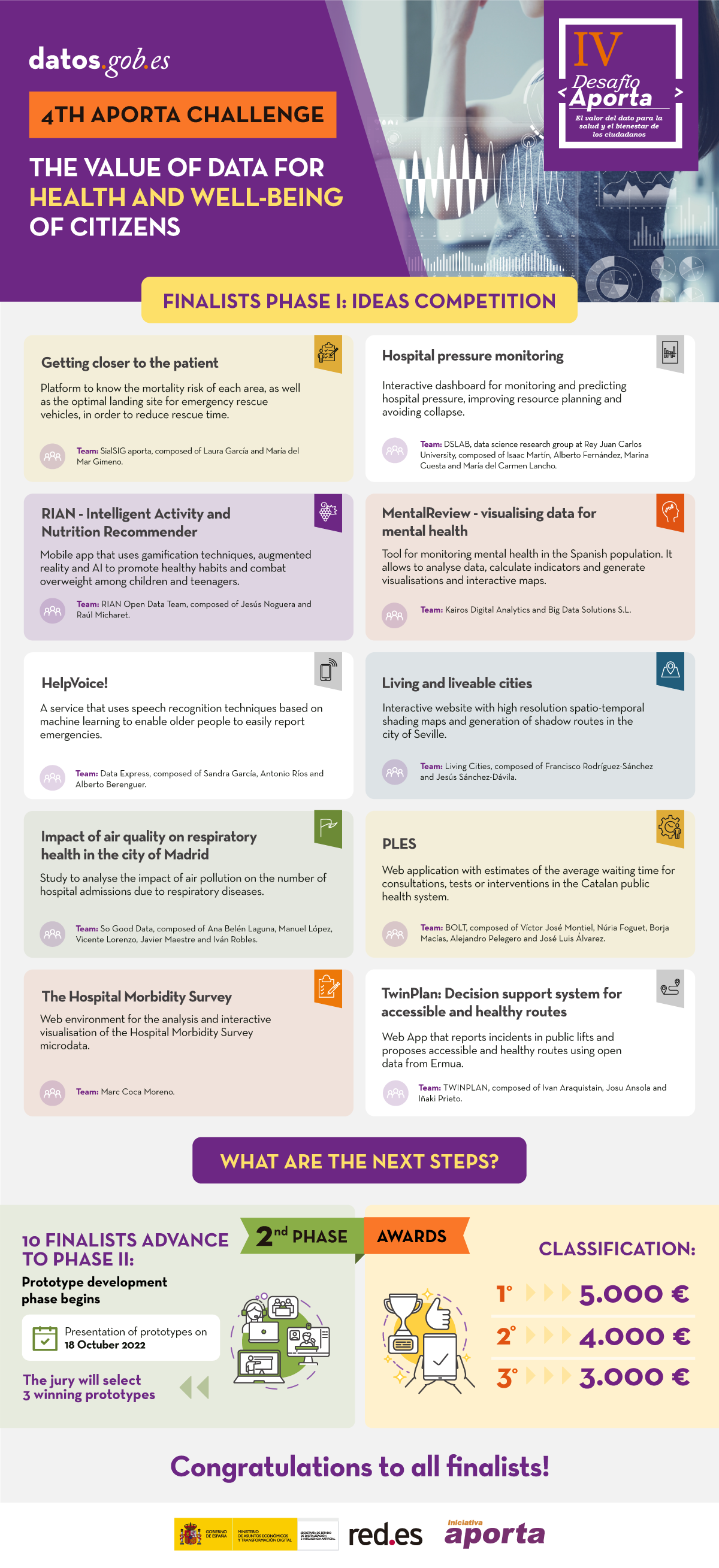
(You can download the accessible version in word here)
The deadline for receiving applications to participate in the IV Aporta Challenge closed on 15 February. In total, 38 valid proposals were received in due time and form, all of high quality, whose aim is to promote improvements in the health and well-being of citizens through the reuse of data offered by public administrations for their reuse.
Disruptive technologies, key to extracting maximum value from data
According to the competition rules, in this first phase, participants had to present ideas that identified new opportunities to capture, analyse and use data intelligence in the development of solutions of all kinds: studies, mobile applications, services or websites.
All the ideas seek to address various challenges related to health and wellbeing, many of which have a direct impact on our healthcare system, such as improving the efficiency of services, optimising resources or boosting transparency. Some of the areas addressed by participants include pressure on the health system, diagnosis of diseases, mental health, healthy lifestyles, air quality and the impact of climate change.
Many of the participants have chosen to use disruptive technologies to address these challenges. Among the proposals, we find solutions that harness the power of algorithms to cross-reference data and determine healthy habits or predictive models that allow us to know the evolution of diseases or the situation of the health system. Some even use gamification techniques. There are also a large number of solutions aimed at bringing useful information to citizens, through maps or visualisations.
Likewise, the specific groups at which the solutions are aimed are diverse: we find tools aimed at improving the quality of life of people with disabilities, the elderly, children, individuals who live alone or who need home care, etc.
Proposals from all over Spain and with a greater presence of women
Teams and individuals from all over Spain have been encouraged to participate in the Challenge. We have representatives from 13 Autonomous Communities: Madrid, Catalonia, the Basque Country, Andalusia, Valencia, the Canary Islands, Galicia, Aragon, Extremadura, Castile and Leon, Castile-La Mancha, La Rioja and Asturias.
25% of the proposals were submitted by individuals and 75% by multidisciplinary teams made up of various members. The same distribution is found between individuals (75%) and legal entities (25%). In the latter category, we find teams from universities, organisations linked to the Public Administration and different companies.
It is worth noting that in this edition the number of women participants has increased, demonstrating the progress of our society in the field of equality. Two editions ago, 38% of the proposals were submitted by women or by teams with women members. Now that number has risen to 47.5%. While this is a significant improvement, there is still work to be done in promoting STEM subjects among women and girls in our country.
Jury deliberation begins
Once the proposals have been accepted, it is time for the jury's assessment, made up of experts in the field of innovation, data and health. The assessment will be based on a series of criteria detailed in the rules, such as the overall quality and clarity of the proposed idea, the data sources used or the expected impact of the proposed idea on improving the health and well-being of citizens.
The 10 proposals with the best evaluation will move on to phase II, and will have a minimum of two months to develop the prototype resulting from their idea. The proposals will be presented to the same jury, which will score each project individually. The three prototypes with the highest scores will be the winners and will receive a prize of 5,000, 4,000 and 3,000 euros, respectively.
Good luck to all participants!
Hackathons, contests or challenges related to data are a different way to test your ideas and/or knowledge, while acquiring new skills. Through this type of competition, solutions to real problems are sought, often in multidisciplinary teams that share diverse knowledge and points of view. In addition to being divnamic and entertaining, they are a great opportunity to give visibility to your work or solution, expand contacts or improve your position in the job market.
Now that the registration period for the IV Aporta Challenge, we wanted to ask the winners of the previous editions how their experience was and what it brought them on a personal and professional level.
From ideas to viable businesses
So far, three Aporta Challenges have been completed, focused on the field of public administration, the agri-food, forestry and rural sector and the digital education, respectively.
The projects presented in the different editions have been very diverse: from master's thesis or research team projects to prototypes of already consolidated companies or ideas that have ended up becoming viable businesses. It is the case of Light, the winner of the first edition of the Challenge, in 2017. Light is an app that encourages people to be more sustainable in their daily lives through gamification, using data from Smart cities. After the Challenge, its creators continued working on the project, developing its business model.
Agesta, for its part, a company already consolidated before the Challenge, which took over the second prize of the II edition with a web system aimed at estimating the volume of poplars on a local scale. Agresta continues to develop highly successful projects both nationally and internationally.
Another example is UniversiDATA-lab, the winning solution in the third edition, whose final was held last summer. It is a public portal for advanced and automatic analysis of datasets published by universities. Also the second prize of this edition, the IPM project, continues to run after the Challenge is over.


Promotion of the labor profile in the market
In many other cases, the Challenge served as a platform to gain visibility and broaden the curriculum, which was influential in attracting the attention of various companies and institutions. This situation has left many creators without time to continue developing the solution presented in the Challenge -although they do not rule out taking it up again in the future-, but it has given them great possibilities for the future.

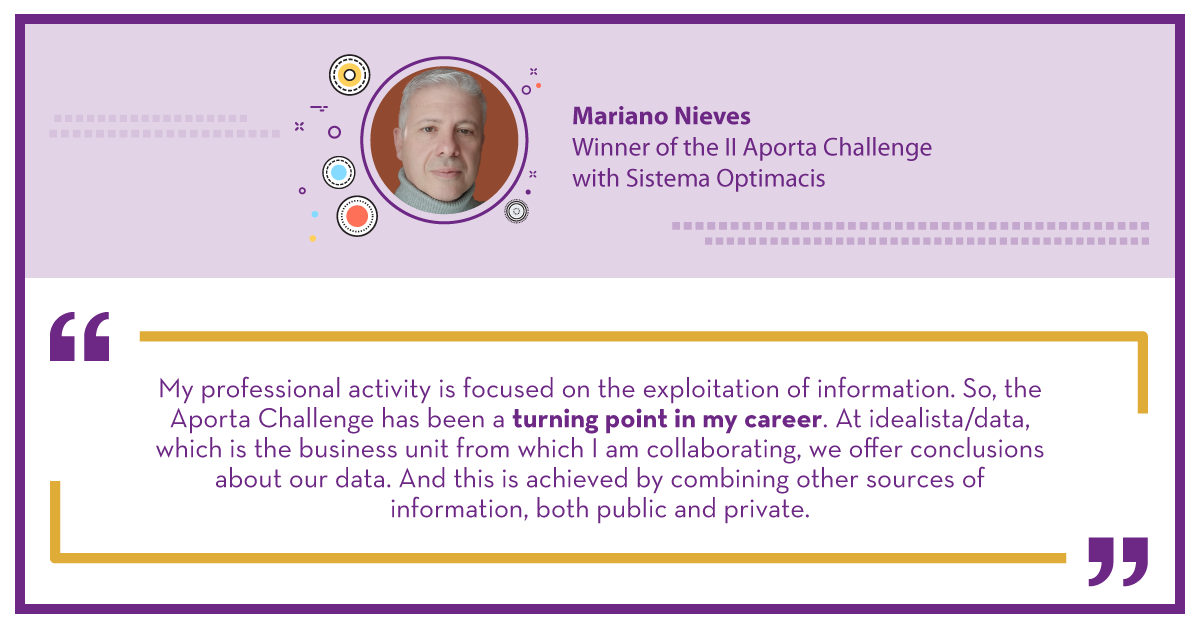

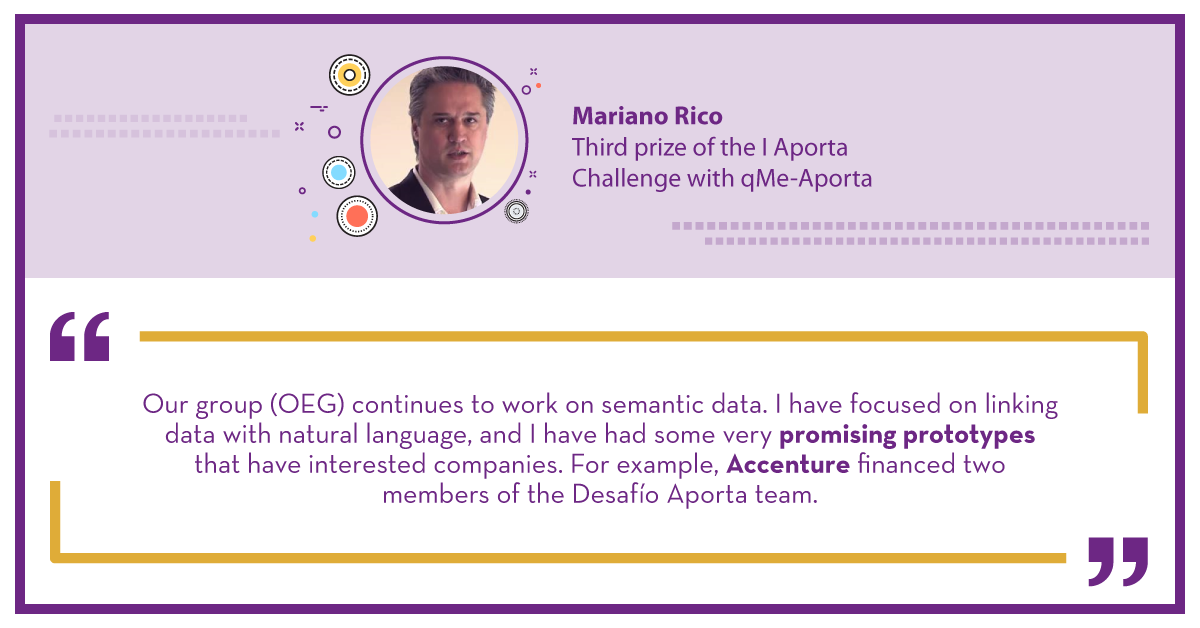
The experience of participating in the Aporta Challenge
But if there is something that the participants in the previous challenges stand out, it is the experience they acquired. The Aporta Challenge was an opportunity to shape an idea and develop a data project from scratch.

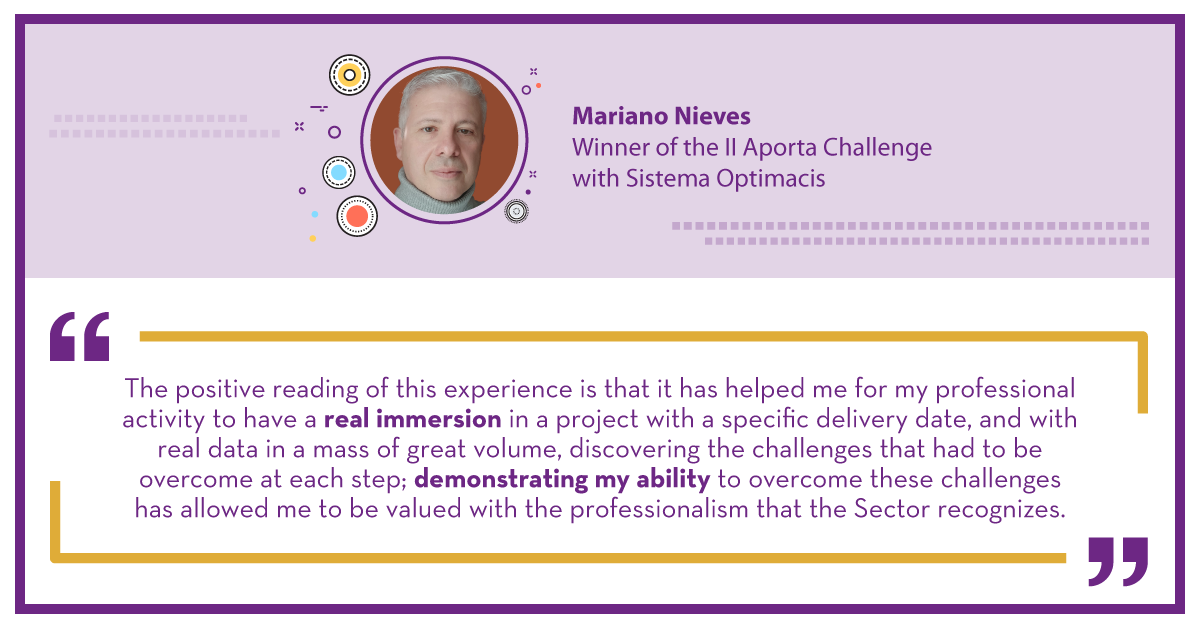
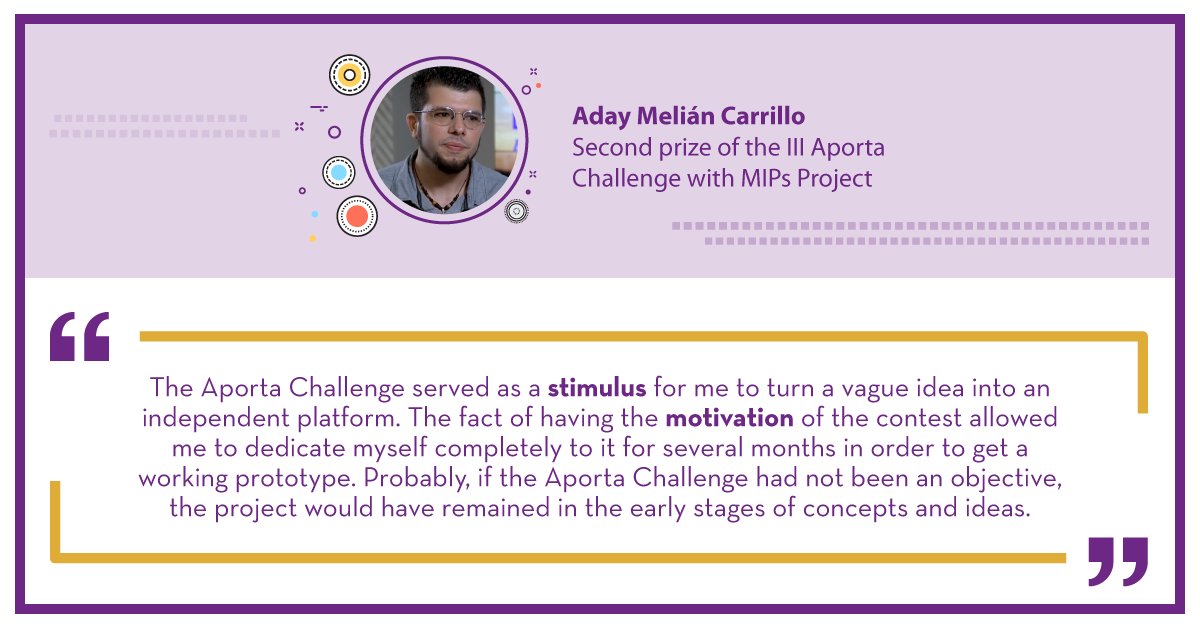

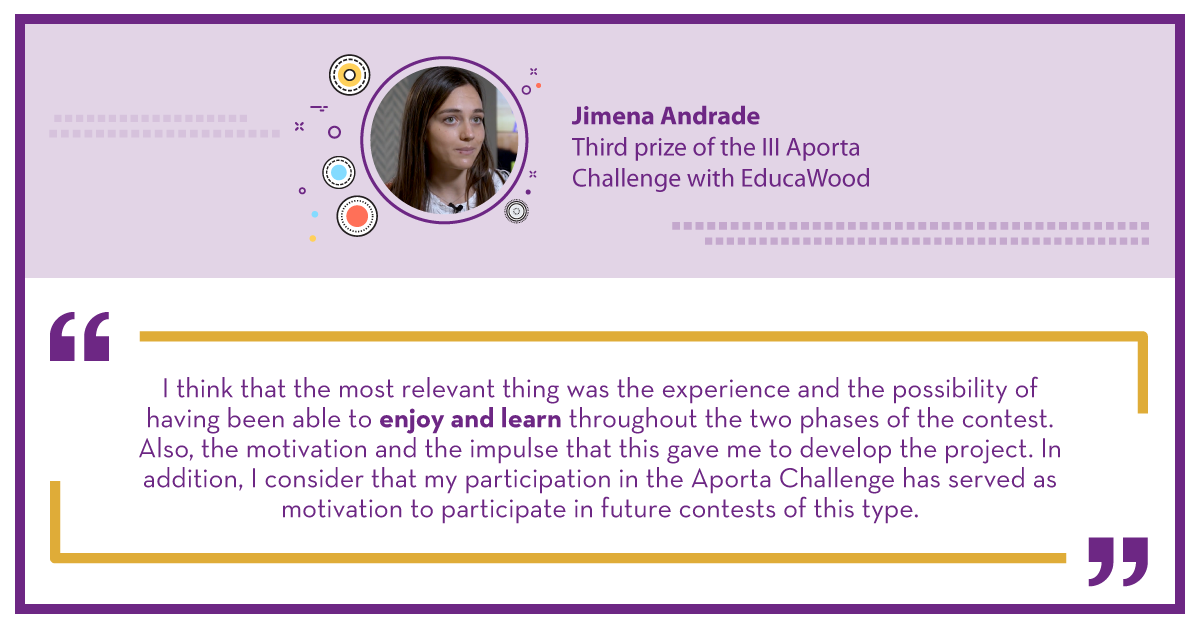

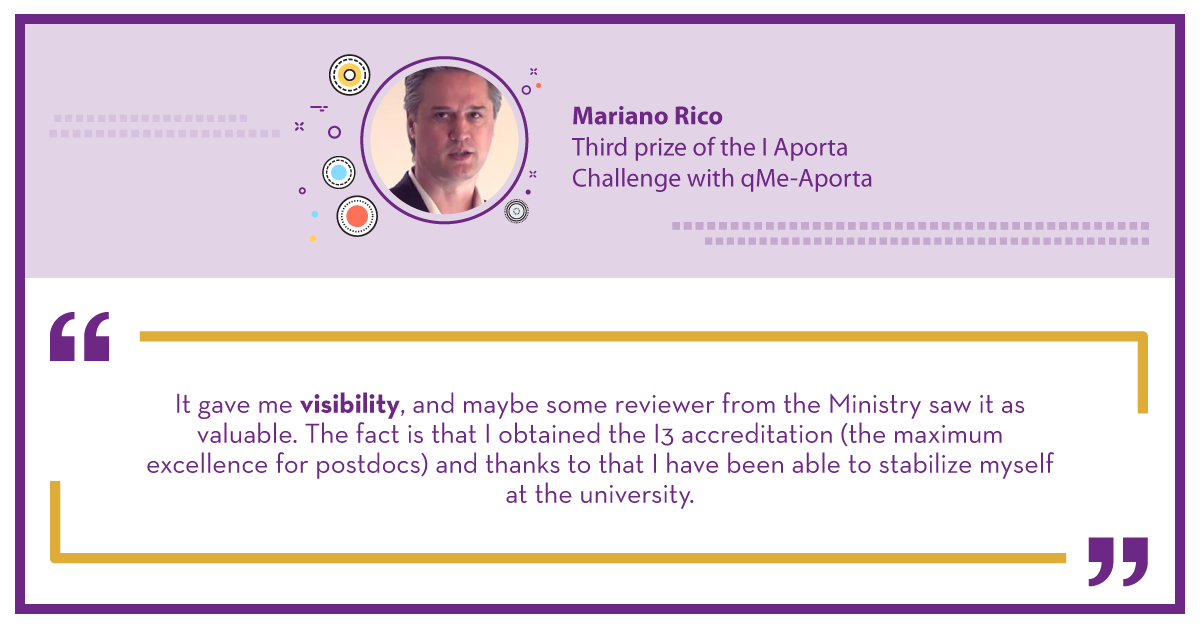
Do you want to participate in the new edition? The term is open until February 15
If you want to follow in the footsteps of the winners of the Aporta Challenge, we inform you that the fourth edition is still open. In this case it seek ideas for solutions aimed at driving improvements in the field of health and wellness, that use open data in their development.
To participate, you just have to fill out the form on the Electronic headquarters of Red.es, indicating what your idea is and its value to society, as well as the data sources you would use. You will also have to upload a video explaining the idea.
You have all the information in our web and in the challenge rules.
Go ahead and put your talent to the test!
Content prepared by the datos.gob.es team.
15 personalities from the field of innovation, data and health will be in charge of evaluating the proposals received at the IV edition of the Aporta Challenge, the competition that seeks to reward ideas and prototypes that promote improvements in a specific sector -in this case health and well-being- through the use of open data.
The names of the members of the jury have become known through a resolution published in the Red.es electronic headquarters. Among them we find representatives of the Public Administrations, organizations linked to the digital economy and the field of the university and data communities. Do you want to know who they are?
Organizations linked to digital advancement
The jury includes a series of representatives of public organizations at the national and regional level focused on the digitization and digital transformation of our country.
- Alberto Palomo Lozano, Chief Data Officer of the Data Office, dependent on the Secretary of State for Digitalization and Artificial Intelligence of the Ministry of Economic Affairs and Digital Transformation (MINECO). Among its functions is the promotion of the sharing, management and use of data throughout all productive sectors.
- Miguel Valle del Olmo, Deputy Director General of Artificial Intelligence and Digital Enabling Technologies f the Secretary of State for Digitalisation and Artificial Intelligence (MINECO), in charge of the design and implementation of the National Artificial Intelligence Strategy of Spain.
- Santiago Graña Dominguez, Deputy Director General of Planning and Governance of the Digital Administration of MINECO. Its aboutbody in charge of promoting the process of rationalization of information and communication technologies in the scope of the General Administration of the State and its Public Bodies.
- Francisco Javier García Vieira, Director of Digital Public Services of Red.es, a public entity promoter of the Digital Agenda in Spain. The Public service area works in three areas: in education, with Educa en Digital and the Educational Posts at Home; in health, with chronicity projects in Andalusia and Extremadura and with a whole range of local and provincial developments through the Smart Territories.
- María Fernández Rancaño, Deputy Director of Digital Public Services of Red.es, unit in charge of the deployment of technological implementation programs in public services of the Administration.
- Zaida Sampedro Loan, Deputy Director General of Services to Ministries and Digital Administration of Madrid Digital, the Agency for Digital Administration of the Community of Madrid.
Entities in the field of health
Given the sectorial nature of the Challenge, representatives of organizations linked to health and well-being have been invited to form part of the jury.
- Carlos Gallego Pérez, Director of Area IA of the Tic Salut Social Foundation of the Department of Health, of the Generalitat de Catalunya. This organismpromotes the development and use of ICT in health and social welfare, functioning as an observatory of new trends and innovation. Among its projects we find initiatives to bring the health field Artificial intelligence and Emerging technologies like 5G.
- Carlos Luis Parra Calderon, Head of the Technological Innovation Section of the Virgen del Rocío University Hospital of the Andalusian Health Service. This center has a R + D + i area focused on Learning Health Systems projects, Language Technologies or Big Data for Healthcare Management, among others.
- Noemí Cívicos Villa, General Director of Digital Health and Information Systems for the National system of health of the Ministry of Health. These are organizations that encompass health benefits and services in Spain.
Business associations
The Aporta Challenge seeks to highlight the power of data as the basis for business models that drive the economy. Therefore, the representatives of business entities could not be absent from the jury.
- Antonio Cimorra Boats, Director of Digital Transformation and Enabling Technologies of Ametic (Multisectoral Association of Information Technology, Communications and Electronics Companies). This association represents companies of all sizes linked to the Spanish digital technology industry.
- Olga Quirós Bonet. Secretary General of ASEDIE (Multisectoral Information Association). ASEDIE represents infomediary companies that, from different sectors, reuse information to create value-added products and services.
- Víctor María Calvo-Sotelo Ibáñez-Martín, Managing Director of Digital (Spanish Association for Digitization), which brings together companies present throughout the digital value chain. DigitalEs is part of the Advisory Council for the Digital Transformation of the Government and is a member of the CEOE board of directors.
Universities and data communities
Students and developers are, among others, two of the target audiences of this competition, and for this reason it was also important to have the participation of data communities and universities.
- Emilio López Cano, Contracted Professor of the Higher Technical School of Computer Engineering of the Rey Juan Carlos University of Madrid. Emilio is also the President of R-Hispano, a community of users and developers whose objective is to promote the advancement of the knowledge and use of the programming language in R.
- Fernando Diaz de Maria, Professor and Head of the Multimedia Processing Group of the Higher Polytechnic School of the Carlos III University of Madrid. This entity has an attractive training offer in data, both in degrees like in postgraduate.
- Maria Sanchez Gonzalez, Associate Professor of the Department of Journalism at the University of Malaga and co-organizer of DataBeers Malaga, a non-profit initiative specialized in dynamic events related to the universe of data, including data open data.
The Secretariat of the Jury, with voice and vote, falls to Sonia Castro García-Muñoz, Coordinator of the Aporta Initiative in the Directorate of Digital Public Services of Red.es.

The registration closing date has been extended to February 15
In the same resolution, the closing date for submitting proposals has also been extended to February 15, 2022 at 1:00 p.m. Those citizens who wish to participate in the Challenge must present before that date an idea for a solution that promotes improvements in the field of health and well-being, using at least one set of data generated by Public Administrations, whether national or international
All the available information is published, together with the bases, in the section Aporta Challenge.
Google is a company with a strong commitment to open data. It has launched Google Dataset Search, to locate open data in existing repositories around the world, and also offers its own datasets in open format as part of its Google Research initiative. In addition, it is a reuser of open data in solutions such as Google Earth.
Among its areas of work is Google for Education, with solutions designed for teachers and students. In datos.gob.es we have interviewed Gonzalo Romero, director of Google for Education in Spain and member of the jury in charge of evaluating the proposals received in the III edition of Desafío Aporta. Gonzalo talked to us about his experience, the influence of open data in the education sector and the importance of open data.
Full interview:
1. What challenges does the education sector face in Spain and how can open data and data-driven technologies help to overcome them?
Last year, due to the pandemic, the education sector was forced to accelerate its digitalization process so that the activity could develop as normally as possible.
The main challenges facing the education sector in Spain are technology and digitization as this sector is less digitized than average. Secure, simple and sustainable digital tools are needed so that the education system, from teachers and students to administrators, can operate easily and without any problems.
Open data makes it possible to locate certain quality information from thousands of sources quickly and easily at any time. These repositories create a reliable data sharing ecosystem that encourages publishers to publish data to drive student learning and the development of technology solutions.
2. Which datasets are most in demand for implementing educational solutions?
Each region usually generates its own. The main challenge is how new datasets can be created in collaboration with the variables that allow them to create predictive models to anticipate the main challenges they face, such as school dropout, personalization of learning or academic and professional orientation, among others.
3. How can initiatives such as hackathons or challenges help drive data-driven innovation? How was your experience in the III Aporta Challenge?
It is essential to support projects and initiatives that develop innovative solutions to promote the use of data.
Technology offers tools that help to find synergies between public and private data to develop technological solutions and promote different skills among students.
4. In addition to being the basis for technological solutions, open data also plays an important role as an educational resource in its own right, as it can provide knowledge in multiple areas. To what extent does this type of resource foster critical thinking in students?
The use of open data in the classroom is a way to boost and foster students' educational skills. For a good use of these resources it is important to search and filter the information according to the needs, as well as to improve the ability to analyse data and argumentation in a reasoned way. In addition, it allows the student to manage technological programs and tools.
These skills are useful for the future not only academically but also in the labour market, since more and more professionals with skills related to analytical capacity and data management are in demand.
5. Through your Google Research initiative, multiple projects are being carried out, some of them linked to the opening and reuse of open data. Why is it important that private companies also open data?
We understand the difficulties that private companies may have if they share data since sharing their information can be an advantage for competitors. However, it is essential to combine public and private sector data to drive the growth of the open data market that can lead to new analyses and studies and the development of new products and services.
It is also important to approach data reuse in the light of new and emerging social challenges and to facilitate the development of solutions without having to start from scratch.
6.What are Google's future plans for open data?
Sensitive corporate data has high survivability requirements, in case a provider has to cancel cloud services due to policy changes in a country or region, and we believe it is not possible to secure data with a proprietary solution. However, we do have open source and open standards tools that address multiple customer concerns.
Data analysis tools such as BigQuery or BigQuery Omni allow customers to make their own data more open, both inside and outside their organization. The potential of that data can then be harnessed in a secure and cost-efficient way. We already have clear use cases of value created with our data and artificial intelligence technology, and endorsed by the CDTI, such as the Student Success data dropout prevention model. Leading educational institutions already use it on a daily basis and it is in pilot phase in some education departments.
The company's goal is to continue working to build an open cloud hand in hand with our local partners and public institutions in Spain and across Europe, creating a secure European digital data ecosystem with the best technology.
Red.es, in collaboration with the Secretary of State for Digitalization and Artificial Intelligence, organizes the fourth edition of the Aporta Challenge. Like other years, it seeks to identify and recognize new ideas and prototypes that drive improvements in a specific sector through the use of open data. This year the focus will be on health and wellness.
The objective is to encourage the talent, technical competence and creativity of the participants while promoting the direct reuse of data published by various public bodies.
Why is it important to promote the use of open data in the health and wellness sector?
If there is one sector where there has been a demand for data in the last year, it has been healthcare, due in part to the global COVID-19 pandemic. However, open data related to health and well-being not only serves to inform citizens in an exercise of transparency, but is also essential as a basis for solutions that drive improvements in health care, the patient experience and services that are offered in order to ensure a better quality of life. Open data has the ability to make essential public services more efficient, effective and inclusive, which in turn contributes to reducing inequality.
Aware of this, the European Commission has among its priorities the creation of a European data space in the health sector. For its part, the Spanish Government has begun actions to establish a data lake sanitary- which will make a large amount of raw data available to researchers so they can analyze it, make predictions, or spot trends. The use of this data, anonymised or in an aggregated form, can generate great improvements that some autonomies are already taking advantage of, such as Andalusia, that works, with the collaboration of Red.es, in the implementation of an advanced analytics system based on Big Data technologies to improve the quality of life of chronic patients.
Under the slogan "The value of data for the health and well-being of citizens" an open competition will be held which, like other years, will consist of two phases:
Phase I: Ideas competition. From 22/11/2021 to 15/02/2022
Participants must present an idea that responds to the proposed challenge: it is about identifying new opportunities to capture, analyze and use data intelligence to drive improvements related to health and well-being.
Proposals must be based on the use of at least one set of open data generated by Public Administrations, whether national or international. These data may be combined with others of a public or private nature.
The idea presented must be original and not have been awarded previously. Previously existing solutions are not valid, but must be developed by the participant within the framework of the Challenge.
A jury made up of experts in the field will assess the ideas presented and will choose 10, which go on to phase II. The criteria that will be taken into account for the evaluation are:
- Relevance
- Quality and overall clarity of the proposed idea
- Impact on the improvement of the educational system of the proposed idea
- Data sources used
- Promotion of the quality of life of vulnerable groups
Phase II: Prototype development and face-to-face exhibition. April-June.
The participants whose ideas have been selected in the previous phase will develop the associated prototype and present it to the members of the Jury. For this they will have a period of 4 months.
The prototypes may be a functional solution, a visualization, dynamic graphic element or multimedia solution that simulates the service or a functional exemplification from the extrapolation of an existing solution, for example, in another sector, country, area, etc.
In this case, the evaluation criteria will be:
- Easy to use
- Technical quality of the prototype
- Viability
- Exhibition quality
The three proposals with the highest score will be the winners and will receive the following financial award:
- First classified: € 5,000
- Second classified: € 4,000
- Third classified: € 3,000
Examples of challenges to solve
Algunos ejemplos de retos a los que pueden dar respuesta las soluciones presentadas son:
- Promote the acquisition and consolidation of healthy habits in citizenship
- Get more effective medical care and improve the patient experience
- Increase public health and epidemiological surveillance capacities
- Obtain better health and wellness outcomes for the dependent, chronically ill, or elderly
- Ensure that all people have the maximum opportunity to preserve their health and well-being
- Optimize the training and development of healthcare professionals
- Promote research to help discover healthy patterns and new treatments
- Encourage the sharing of successful experiences
- Leverage data to improve patient and service user safety
Who can participate?
Registration is open to any person, team or company domiciled in the European Union, who wants to contribute to economic and social development in the field of health and well-being.
How can I sign up?
You can register through the red.es electronic area. For this you will need your password or electronic certificate. The deadline ends on February 15, 2022 at 1:00 p.m.
You must include a detailed description of your idea and its value to society, as well as a descriptive video of the idea in Spanish, between 120 and 180 seconds long.
You have all the information at red.es and the bases of the Challenge.
Get inspired by the finalist works from previous editions!
For inspiration, look at work from previous years.
- III Challenge Aporta: "The value of data in digital education"
- II Challenge Aporta: "The value of data for the agri-food, forestry and rural sectors"
- I Challenge Provides: "The value of data for the Administration"
Go ahead and participate!
If you would like to help spread this information to others, we offer materials (in Spanish) that will make it easier for you:

The Aporta Challenges are awards for new ideas and prototypes that, making use of open data, lead to efficiency improvements in a specific sector of activity. In this section you will find infographics with information about the different editions carried out.
I Aporta challenge: The value of the data for the Administration
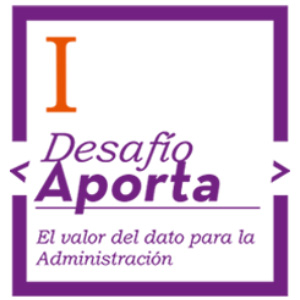 |
II Aporta Challenge: The value of data to the agri-food, forestry and rural sector
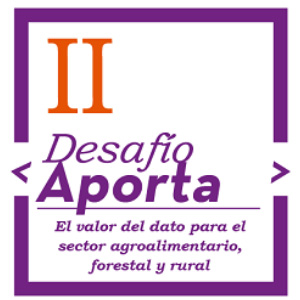 |
III Aporta challenge: The value of data in digital education
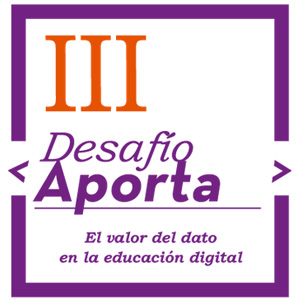 |
IV Aporta Challange: The value of data for health and well-being of citizens
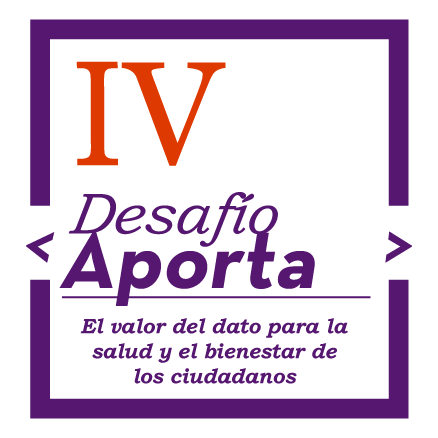 |
Open data is not only a matter of public administrations, more and more companies are also betting on them. This is the case of Microsoft, who has provided access to selected open data in Azure designed for the training of Machine Learning models. He also collaborates in the development of multiple projects in order to promote open data. In Spain, it has collaborated in the development of the platform HealthData 29, intended for the publication of open data to promote medical research.
We have interviewed Belén Gancedo, Director of Education at Microsoft Ibérica and member of the jury in the III edition of the Aporta Challenge,focused on the value of data for the education sector. We met with her to talk about the importance of digital education and innovative data-driven solutions, as well as the importance of open data in the business sector.
Complete interview:
1. What challenges in the education sector, to which it is urgent to respond, has the pandemic in Spain revealed?
Technology has become an essential element in the new way of learning and teaching. During the last months, marked by the pandemic, we have seen how a hybrid education model - face-to-face and remotely - has changed in a very short time. We have seen examples of centers that, in record time, in less than 2 weeks, have had to accelerate the digitization plans they already had in mind.
Technology has gone from being a temporary lifeline, enabling classes to be taught in the worst stage of the pandemic, to becoming a fully integrated part of the teaching methodology of many schools. According to a recent YouGov survey commissioned by Microsoft, 71% of elementary and middle school educators say that technology has helped them improve their methodology and improved their ability to teach. In addition, 82% of teachers report that the pace at which technology has driven innovation in teaching and learning has accelerated in the past year.
Before this pandemic, in some way, those of us who had been dedicating ourselves to education were the ones who defended the need to digitally transform the sector and the benefits that technology brought to it. However, the experience has served to make everyone aware of the benefits of the application of technology in the educational environment. In that sense, there has been an enormous advance. We have seen a huge increase in the use of our Teams tool, which is already used by more than 200 million students, teachers, and education staff around the world.
The biggest challenges, then, currently, are to not only take advantage of data and Artificial Intelligence to provide more personalized experiences and operate with greater agility, but also the integration of technology with pedagogy, which will allow more flexible, attractive learning experiences and inclusive. Students are increasingly diverse, and so are their expectations about the role of college education in their journey to employment.
The biggest challenges, then, currently, are to not only take advantage of data and Artificial Intelligence to provide more personalized experiences and operate with greater agility, but also the integration of technology with pedagogy, which will allow more flexible, attractive learning experiences and inclusive.
2. How can open data help drive these improvements? What technologies need to be implemented to drive improvements in the efficiency and effectiveness of the learning system?
Data is in all aspects of our lives. Although it may not be related to the mathematics or algorithm that governs predictive analytics, its impact can be seen in education by detecting learning difficulties before it is too late. This can help teachers and institutions gain a greater understanding of their students and information on how to help solve their problems.
Predictive analytics platforms and Artificial Intelligence technology have already been used with very positive results by different industries to understand user behavior and improve decision-making. With the right data, the same can be applied in classrooms. On the one hand, it helps to personalize and drive better learning outcomes, to create inclusive and personalized learning experiences, so that each student is empowered to succeed. If its implementation is correct, it allows a better and greater monitoring of the needs of the student, who becomes the center of learning and who will enjoy permanent support.
At Microsoft we want to be the ideal travel companion for the digital transformation of the education sector. We offer educational entities the best solutions -cloud and hardware- to prepare students for their professional future, in a complete environment of collaboration and communication for the classroom, both in face-to-face and online models. Solutions like Office 365 Education and the Surface device are designed precisely to drive collaboration both inside and outside the classroom. The educational version of Microsoft Teams makes a virtual classroom possible. It is a free tool for schools and universities that integrates conversations, video calls, content, assignments and applications in one place, allowing teachers to create learning environments that are lively and accessible from mobile devices,
And, in addition, we make available to schools, teachers and students devices specifically designed for the educational environment, such as the Surface Go 2, expressly designed for the educational environment. It is an evolutionary device, that is, it adapts to any educational stage and boosts the creativity of students thanks to its power, versatility and safety. This device allows the mobility of both teachers and students inside and outside the classroom; connectivity with other peripheral devices (printers, cameras ...); and includes the Microsoft Classroom Pen for natural writing and drawing in digital ink.
3. There is increasing demand for digital skills and competencies related to data. In this sense, the National Plan for Digital Skills, which includes the digitization of education and the development of digital skills for learning. What changes should be made in educational programs in order to promote the acquisition of digital knowledge by students?
Without a doubt, one of the biggest challenges we face today is the lack of training and digital skills. According to a study carried out by Microsoft and EY, 57% of the companies surveyed expect AI to have a high or very high impact in business areas that are "totally unknown to companies today."
There is a clear opportunity for Spain to lead in Europe in digital talent, consolidating itself as one of the most attractive countries to attract and retain this talent. A recent LinkedIn study anticipates that two million technology-related jobs will be created in Spain in the next five years, not only in the technology industry, but also,and above all, in companies in other sectors of activity that seek to incorporate the necessary talent to carry out their transformation. However, there is a shortage of professionals with skills and training in digital skills. According to data from the Digital Economy and Society Index Report published annually by the European Commission, Spain is below the European average in most of the indicators that refer to the digital skills of Spanish professionals.
There is, therefore, an urgent demand to train qualified talent with digital skills, data management, AI, machine learning ... Technology-related profiles are among the most difficult to find and, in the near future, those related to technology data analytics, cloud computing and application development.
For this, adequate training is necessary, not only in the way of teaching, but also in the curricular content. Any career, not just those in the STEM field, would need to include subjects related to technology and AI, which will define the future. The use of AI reaches any field, not only technology, therefore, students of any type of career -Law, Journalism ... - to give some examples of non-STEM careers, need qualified training in technology such as AI or data science, since they will have to apply it in their professional future.
We must bet on public-private collaborations and involve the technology industry, public administrations, the educational community, adapting the curricular contents of the University to the labor reality- and third sector entities, with the aim of promoting employability and professional recycling. In this way, the training of professionals in areas such as quantum computing, Artificial Intelligence, or data analytics and we can aspire to digital leadership.
In the next five years, two million technology-related jobs will be created in Spain, not only in the technology industry, but also, and above all, in companies in other sectors of activity that seek to incorporate the necessary talent to lead carry out your transformation.
4. Even today we find a disparity between the number of men and women who choose professional branches related to technology. What is needed to promote the role of women in technology?
According to the National Observatory of Telecommunications and Information Society -ONTSI- (July 2020), the digital gender gap has been progressively reduced in Spain, going from 8.1 to 1 point, although women maintain an unfavorable position in digital skills and Internet use. In advanced skills, such as programming, the gap in Spain is 6.8 points, the EU average being 8 points. The percentage of researchers in the ICT services sector drops to 23.4%. And in terms of the percentage of graduates in STEM, Spain ranks 12th within the EU, with a difference between the sexes of 17 points.
Without a doubt, there is still a long way to go. One of the main barriers that women face in the technology sector and when it comes to entrepreneurship are stereotypes and cultural tradition. The masculinized environment of technical careers and stereotypes about those who are dedicated to technology make them unattractive careers for women.
Digitization is boosting the economy and promoting business competitiveness,as well as generating an increase in the creation of specialized employment. Perhaps the most interesting thing about the impact of digitization on the labor market is that these new jobs are not only being created in the technology industry, but also in companies from all sectors, which need to incorporate specialized talent and digital skills.
Therefore, there is an urgent demand to train qualified talent with digital capabilities and this talent must be diverse. The woman cannot be left behind. It is time to tackle gender inequality, and alert everyone to this enormous opportunity, regardless of their gender. STEM careers are an ideal future option for anyone, regardless of gender.
Forfavor the female presence in the technology sector, in favor of a digital era without exclusion, at Microsoft we have launched different initiatives that seek to banish stereotypes and encourage girls and young people to take an interest in science and technology and make them see that they they can also be the protagonists of the digital society. In addition to the WONNOW Awards that we convened with CaixaBank, we also participate and collaborate in many initiatives, such as the Ada Byron Awards together with the University of Deusto, to help give visibility to the work of women in the STEM field, so that they are references of those who They are about to come.
The digital gender gap has been progressively reduced in Spain, going from 8.1 to 1 point, although women maintain an unfavorable position in digital skills and Internet use. In advanced skills, such as programming, the gap in Spain is 6.8 points, the EU average being 8 points.
5. How can initiatives like hackathons, challenge or challenges help drive data-driven innovation? How was your experience in the III Aporta Challenge?
These types of initiatives are key to that much-needed change. At Microsoft we are constantly organizing hackathons on a global, regional and local scale, to innovate in different priority areas for the company, such as education.
But we go further. We also use these tools in class. One of Microsoft's bets is the projects STEM hacking.These are projects in which the “maker” concept of learning by doing with programming and robotics is mixed, through the use of everyday materials. What's more,They are made up of activities that allow teachers to guide their students to construct and create scientific instruments and project-based tools to visualize data through science, technology, engineering, and mathematics. Our projects -both Hacking STEM as well as coding and computational language through the use of free tools such as Make Code- aim to bring programming and robotics to any subject in a transversal way, and why not, learn programming in a Latin class or in a biology one.
My experience in the III Aporta Challenge has been fantastic because it has allowed me to learn about incredible ideas and projects where the usefulness of the amount of data available becomes a reality and is put at the service of improving the education of all. There has been a lot of participation and, in addition, with very careful and worked presentations. The truth is that I would like to take this opportunity to thank everyone who has participated and also congratulate the winners.
6. A year ago, Microsoft launched a campaign to promote open data in order to close the gap between countries and companies that have the necessary data to innovate and those that do not. What has the project consisted of? What progress has been made?
Microsoft's global initiative Open Data Campaign seeks to help close the growing “data gap” between the small number of technology companies that benefit most from the data economy today and other organizations that are hampered by lack of access to data or lack of capabilities to use the ones you already have.
Microsoft believes that more needs to be done to help organizations share and collaborate around data so that businesses and governments can use it to meet the challenges they face, as the ability to share data has huge benefits. And not only for the business environment, but they also play a critical role in helping us understand and address major challenges, such as climate change, or health crises, such as the COVID-19 pandemic. To take full advantage of them, it is necessary to develop the ability to share them in a safe and reliable way, and to allow them to be used effectively.
Within the Open Data Campaign initiative, Microsoft has announced 5 great principles that will guide how the company itself approaches how to share its data with others:
- Open- Will work to make relevant data on large social issues as open as possible.
- Usable- Invest in creating new technologies and tools, governance mechanisms and policies so that data can be used by everyone.
- Boosters- Microsoft will help organizations generate value from their data and develop AI talent to use it effectively.
- Insurance- Microsoft will employ security controls to ensure data collaboration is secure at the operational level.
- Private- Microsoft will help organizations protect the privacy of individuals in data-sharing collaborations that involve personally identifiable information.
We continue to make progress in this regard. Last year, Microsoft Spain, next to Foundation 29, the Chair on Privacy and Digital Transformation Microsoft-Universitat de València and with the legal advice of the law firm J&A Garrigues have created the Guide "Health Data"that describes the technical and legal framework to carry out the creation of a public repository of health systems data, and that these can be shared and used in research environments and LaLiga is one of the entities that has shared, in June of this year, its anonymized data.
Data is the beginning of everything and one of our biggest responsibilities as a technology company is to help conserve the ecosystem on a large scale, on a planetary level. For this, the greatest challenge is to consolidate not only all the available data, but the artificial intelligence algorithms that allow access to it and allow making decisions, creating predictive models, scenarios with updated information from multiple sources. For this reason, Microsoft launched the concept of Planetary Computer, based on Open Data, to make more than 10 Petabytes of data - and growing - available to scientists, biologists, startups and companies, free of charge, from multiple sources (biodiversity, electrification , forestry, biomass, satellite), APIs, Development Environments and applications (predictive model, etc.) to create a greater impact for the planet.
Microsoft's global initiative Open Data Campaign seeks to help close the growing “data gap” between the small number of technology companies that benefit most from the data economy today and other organizations that are hampered by lack of access to data or lack of capabilities to use the ones you already have.
7. They also offer some open data sets through their Azure Open Datasets initiative. What kind of data do they offer? How can users use them?
This initiative seeks that companies improve the accuracy of the predictions of their Machine Learning models and reduce the time of data preparation, thanks to selected data sets of public access, ready to use and easily accessible from the Azure services.
There is data of all kinds: health and genomics, transport, labor and economy, population and security, common data ... that can be used in multiple ways. And it is also possible to contribute datasets to the community.
8. Which are the Microsoft's future plans for open data?
After a year with the Opendata campaign, we have had many learnings and, in collaboration with our partners, we are going to focus next year on practical aspects that make the process of data sharing easier. We just started publishing materials for organizations to see the nuts and bolts of how to start sharing data. We will continue to identify possible collaborations to solve social challenges on issues of sustainability, health, equity and inclusion. We also want to connect those who are working with data or want to explore that realm with the opportunities offered by the Microsoft Certifications in Data and Artificial Intelligence. And, above all, this issue requires a good regulatory framework and, for this, it is necessary that those who define the policies meet with the industry.
After months of work, the 3rd Aporta Challenge has come to an end. Under the slogan "the value of data in digital education", this year's competition sought solutions that used open data to drive improvements in the education sector.
The competition, organised by the Aporta Initiative, launched by Red.es together with the Secretary of State for Digitalisation and Artificial Intelligence, began in October 2020, with a first phase consisting of an ideas competition. After the jury's assessment, 10 finalists were chosen and have had three months to transform their ideas into a prototype. These prototypes were presented on 22 June in an online session.
10 proposals that stand out for their quality
The 10 papers presented are a great example of the power of open data to transform the education sector, improving its effectiveness and efficiency. The need for universal access to knowledge through inclusive and quality education has become even more evident in the current pandemic context. Open data can help to meet this challenge. Open data can be analysed and used to shape solutions that help to improve the student experience in the learning process, for example through personalisation of education, identification of behavioural problems or informed decision-making, among other issues.
All the entries were of a high quality, reflecting the efforts of all the finalist teams. The jury, made up of experts representing companies, public administrations and organisations linked to the digital economy and the academic world, had a difficult time choosing the three winners. In the end, the three winners were UniversiDATA-Lab, MIP Project and EducaWood, who received prizes of €4,000, €3,000 and €2,000 respectively.
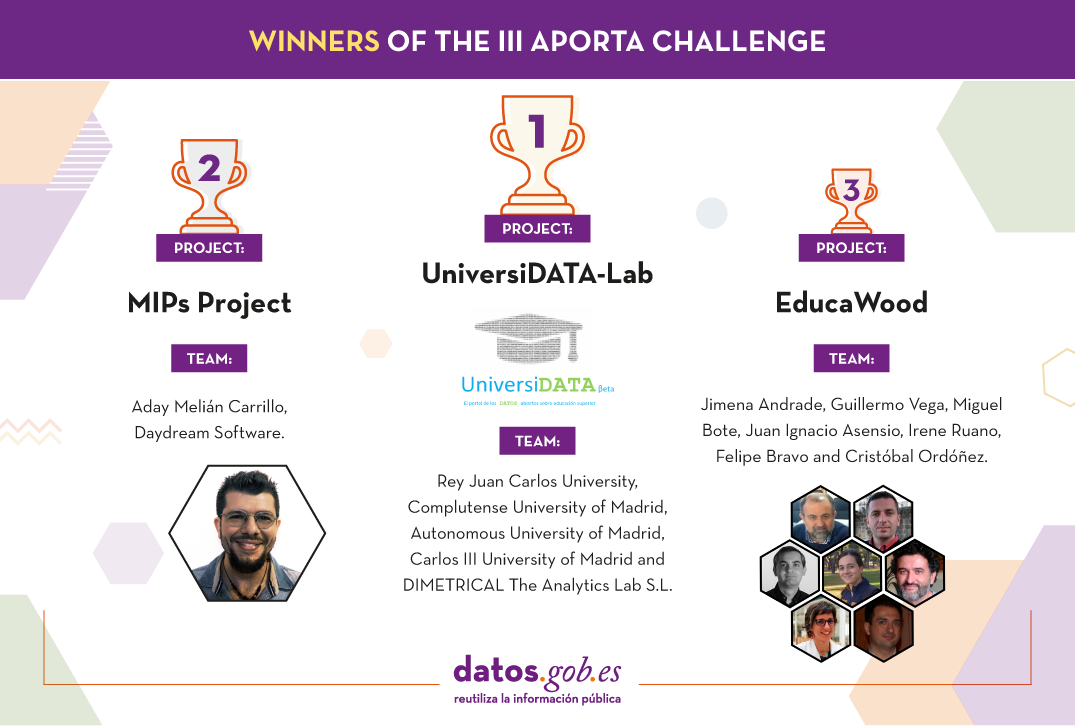
First prize: UniversiDATA-Lab
-
Team: Rey Juan Carlos University, Complutense University of Madrid, Autonomous University of Madrid, Carlos III University of Madrid and DIMETRICAL The Analytics Lab S.L.
The first prize went to UniversiData-Lab, a public portal for the advanced and automatic analysis of datasets published by universities. It is a complementary project to UniversiData: while the objective of UniversiDATA is to facilitate access to high quality university datasets with standard formats and criteria, the objective of UniversiDATA-Lab is to enhance the value of these datasets, carrying out advanced and automatic analysis of them, taking advantage of the homogeneity of the content.
UniversiDATA-Lab offers a catalogue of applications created thanks to the application of advanced analysis and visualisation techniques, carried out in R language. In the online session they showed the analysis of interurban commuting, the analysis of CO2 generated by student commuting and the analysis of gender differences in the different university branches.
These analyses can be instrumental in helping universities to make decisions related to administration and management, with major benefits for the environment, the economy and society.
Screenshots of UniversiDATA-Lab
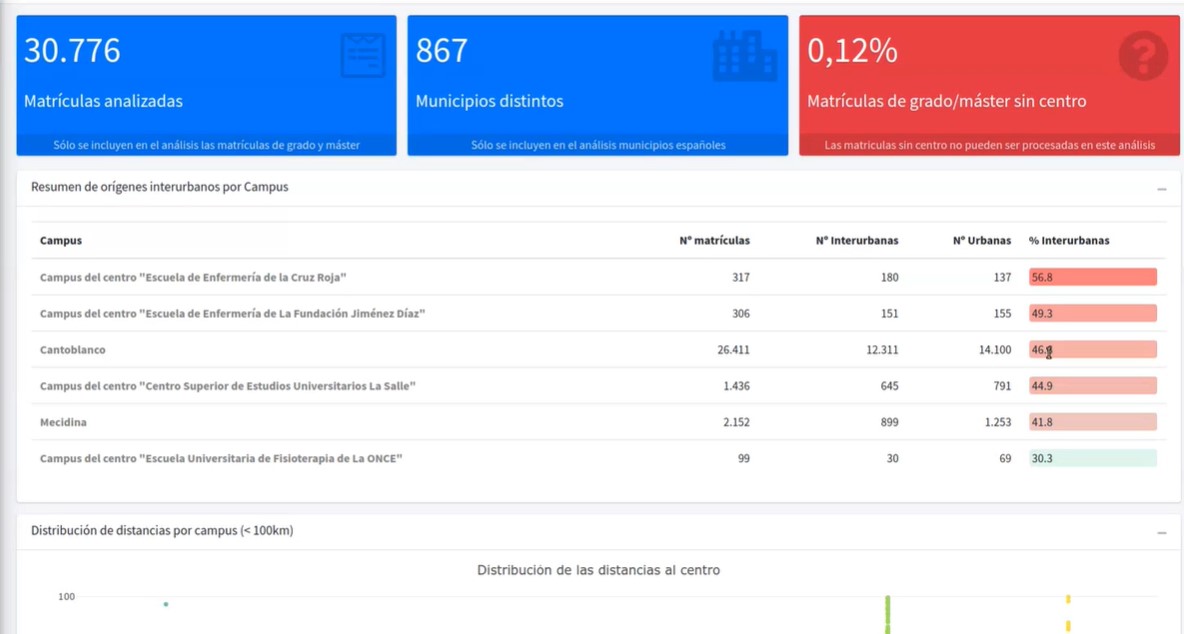
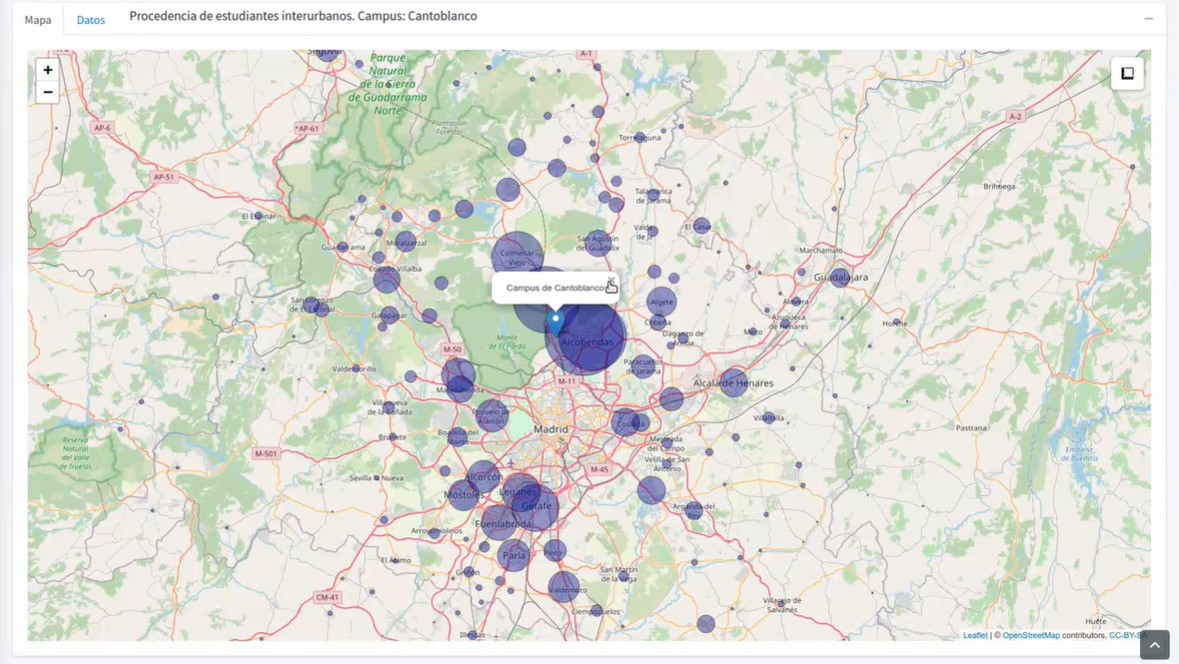
Second prize: MIP Project
- Team: Aday Melián Carrillo, Daydream Software.
MIP Project, the second prize winner, is an online service where any user can register and start creating MIPs (Marked Information Pictures). A MIP is an information format consisting of a series of interactive layers over static images that facilitate the retention of information and the identification of elements.
The prototype includes a Python converter from GeoJSON open data to the format needed to develop interactive atlases. It also offers a public cloud of freely accessible MIPs for consultation, study or independent learning.
Thanks to this tool, teachers can create MIPs quickly and easily by manually drawing regions of interest on any image imported through the web. A more enjoyable way to educate and to attract students' attention more easily.
Screenshots of MIP Project
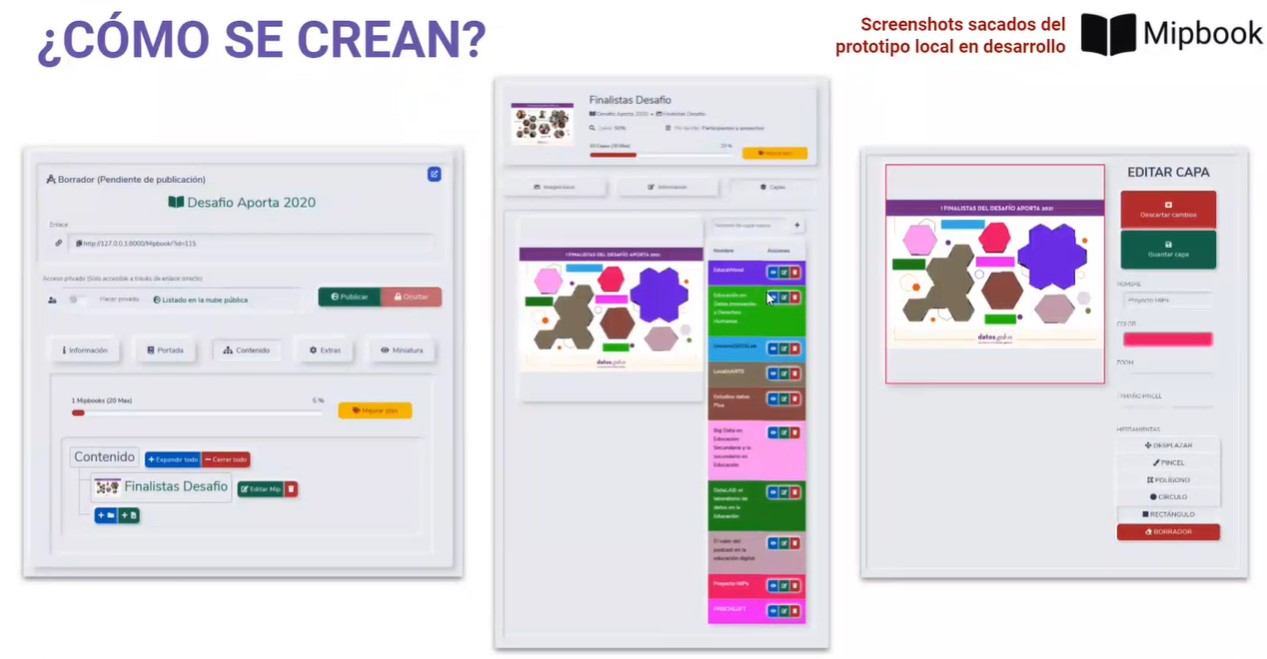
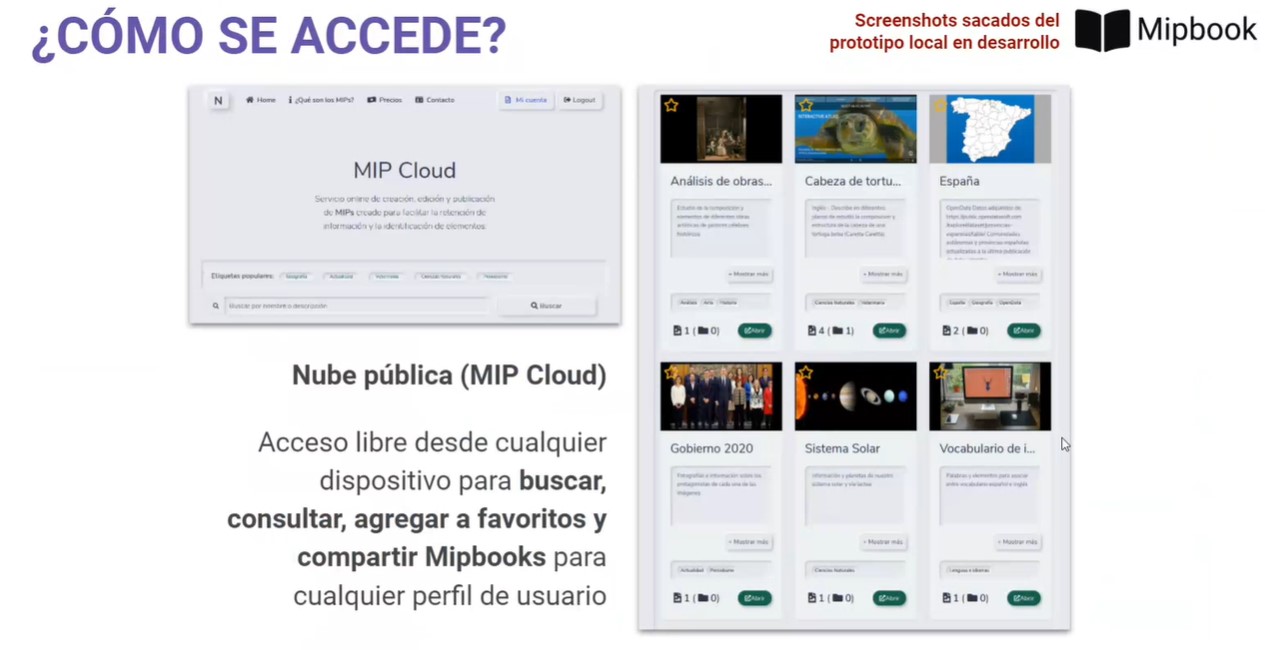
Third prize EducaWood
-
Team: Jimena Andrade, Guillermo Vega, Miguel Bote, Juan Ignacio Asensio, Irene Ruano, Felipe Bravo and Cristóbal Ordóñez.
EducaWood is a socio-semantic web portal that allows you to explore the forest information of an area of Spanish territory and enrich it with tree annotations. Its aim is to promote environmental learning activities, one of the main aspects of UNESCO's "Education for Sustainable Development Goals", which is part of the Spanish Government's Agenda 2030.
Thanks to the use of EducaWood, teachers can propose activities that students can carry out either face-to-face or online (through virtual field visits). In the face-to-face modality, students visit natural areas and make annotations of trees, such as location and identification of species, measurements, microhabitats, photos, etc. These annotations become available to the whole community as open data, thus enabling the application to be used remotely. These data are also enriched with other sources such as the Spanish Forest Map, the National Forest Inventory, GeoNames or DBPedia.
EducaWood helps students to learn more about their environment, while promoting ecological awareness.
Screenshots of Educawood
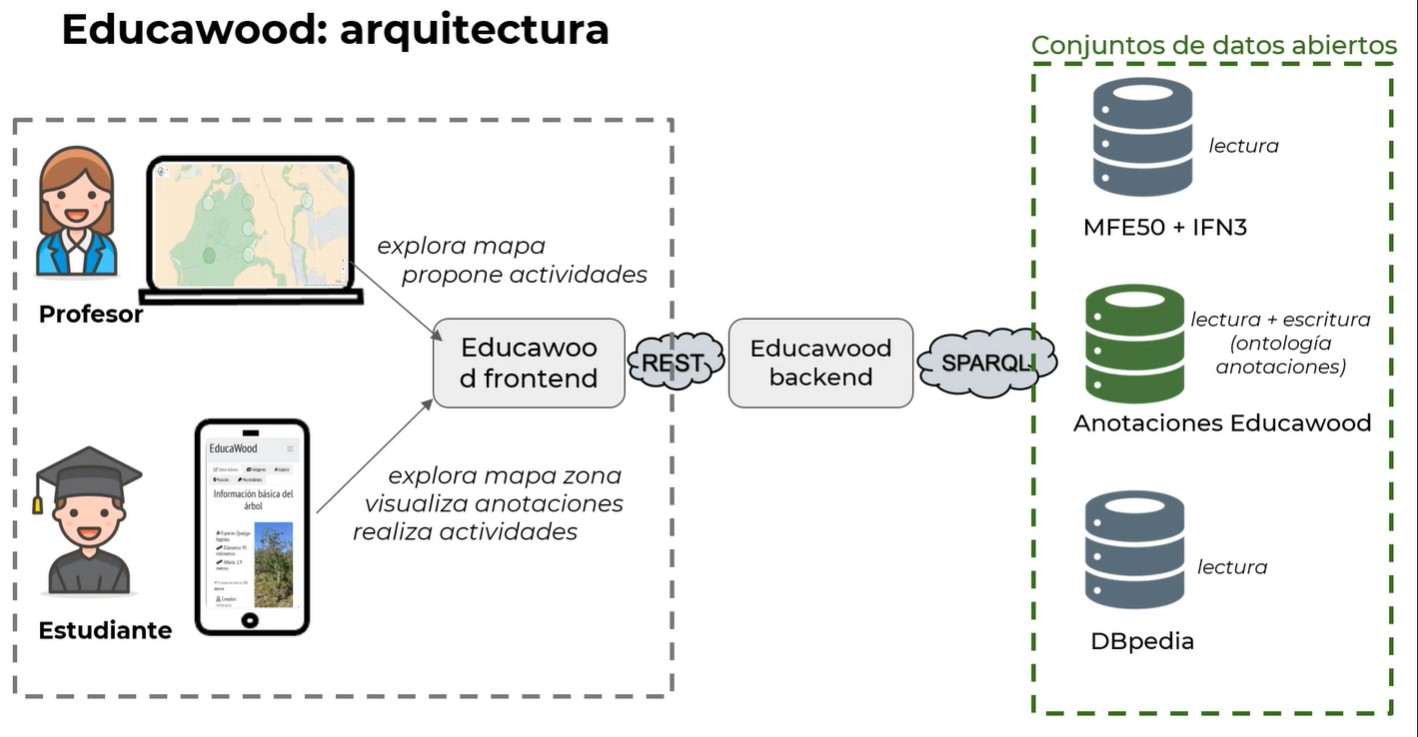
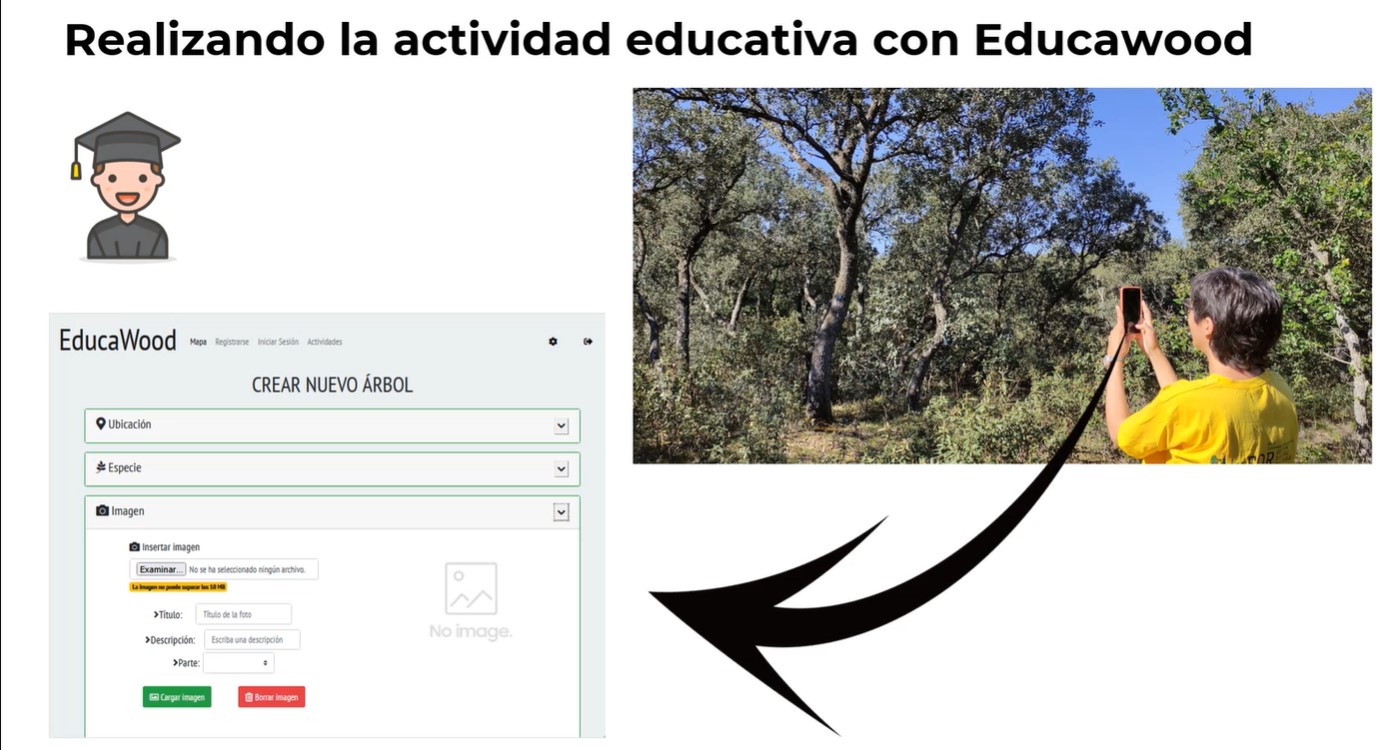
Alberto Martínez Lacambra, Director General of Red.es, presents the awards
The awards to the three winners were announced on 8 July at a ceremony held at Red.es headquarters.
The three awards were announced by Alberto Martínez Lacambra, Director General of Red.es, who highlighted education as a key element in the evolution of a society marked by the pandemic, as well as the need to work to reduce the digital and social divide that still exists. He thanked all the participants for their participation, highlighting the quality of their work.
The event was attended by several members of the jury, who were able to talk to the three winning teams.
In the following video you can see how the event took place. Photos are also available on our Flickr account.
At datos.gob.es we are already working to shape the IV Aporta Challenge, which we hope to announce in the coming months.
